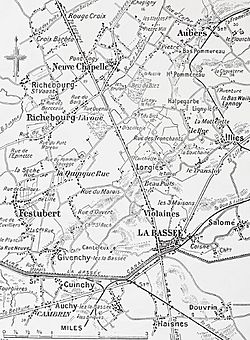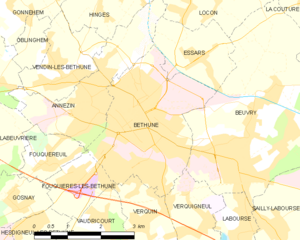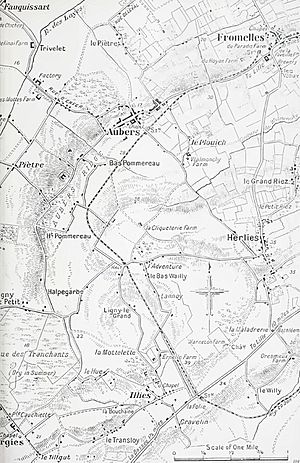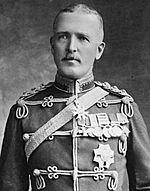Battle of La Bassée facts for kids
Quick facts for kids Battle of La Bassée |
|||||||
|---|---|---|---|---|---|---|---|
| Part of the Race to the Sea on the Western Front (First World War) | |||||||
 Neuve Chapelle to La Bassée area, 1914 |
|||||||
|
|||||||
| Belligerents | |||||||
|
|
|||||||
| Commanders and leaders | |||||||
| Sir John French, Horace Smith-Dorrien James Willcocks Louis de Maud'huy Louis Conneau |
Crown Prince Rupprecht | ||||||
| Strength | |||||||
| II Corps 2nd Cavalry Brigade Lahore Division French II Cavalry Corps (detachments) |
6th Army | ||||||
| Casualties and losses | |||||||
| c. 15,000 | 6,000 | ||||||
The Battle of La Bassée was a fight between German, French, and British armies in northern France. It happened in October 1914 during the early part of World War I. Both sides were trying to outflank (go around the side of) the other's army, in what was called the Race to the Sea.
The German 6th Army captured the city of Lille before British forces could get there. Another German army, the 4th Army, attacked the British further north near Ypres. The British were pushed back, and the German army took control of La Bassée and Neuve Chapelle.
Around October 15, the British managed to take back Givenchy-lès-la-Bassée. However, they could not get La Bassée itself. German reinforcements arrived, giving them the upper hand again. But then, the Lahore Division from the Indian Corps joined the British side.
The British fought off German attacks until early November. After that, both sides focused their efforts on the First Battle of Ypres. The fighting at La Bassée became smaller, local battles. In early 1915, there were more small fights and raids, but the front line barely changed.
Contents
Why the Battle Happened
The Race to the Sea
From mid-September to mid-October 1914, both sides tried to get around the northern end of their enemy's army. This was like a race to see who could reach the English Channel first. The French commander, Joffre, moved his armies north. The German commander, Falkenhayn, did the same.
When the French moved, they expected to find an open area to attack. Instead, they ran into German forces. Both armies kept extending their lines north, trying to find an open flank. But each time, they met the enemy doing the same thing. This meant the "open" northern flank disappeared.
The Difficult Land of Flanders

The area where the battle happened is called Flanders. It's in north-east France and south-west Belgium. This land is mostly flat, with some low hills. It has many canals, ditches, and rivers.
The ground was often wet and marshy, especially in autumn. This made it very hard to dig trenches. Soldiers often had to build "breastworks" (walls built upwards) instead. These were easy to see and destroy with artillery. The ground could also turn into a "cream cheese" consistency, making movement very difficult.
The area also had many small fields, woods, and hedgerows. This made it hard for soldiers to see what was happening. It was also difficult for cavalry and artillery to move around. South of La Bassée Canal, there were coal mines with slag heaps and miners' houses. North of the canal were cities like Lille, with many factories.
Getting Ready for Battle
British and French Plans
By October 4, French troops near Lille were in danger of being surrounded. To help, the British Expeditionary Force (BEF) began moving to Flanders. They planned to join the French Tenth Army.
On October 8, the British II Corps arrived by train. They were ordered to advance towards Béthune. British cavalry covered their arrival. On October 10, II Corps moved quickly using French buses. By October 11, they held a line near Béthune.
On October 12, II Corps attacked to reach a line from Givenchy to Pont du Hem. The German defenders fought hard, but the British slowly advanced. A German counter-attack near Givenchy was pushed back. On October 13, the British 3rd Division and French cavalry attacked but gained little ground. The British lost about 1,000 soldiers.
German Plans
The German 6th Army arrived in northern France and Flanders. They took over from German cavalry divisions. The German 6th Army was told not to attack until the new 4th Army began its operations in Belgium.
Both German armies attacked on October 20. The 6th Army attacked from Arras to Armentières. The next day, the northern part of the 6th Army attacked from La Bassée to St Yves. They gained little ground. But their attacks stopped British and French troops from moving north to help at Ypres.
On October 27, the German command ordered the 6th Army to move heavy artillery north. This was for a big attack planned for October 29 at Gheluvelt. This meant the 6th Army would reduce its attacks further south, including against the British II Corps.
The Battle Begins
British and French Attacks (October 14–20)
On October 14 and 15, the British II Corps attacked near La Bassée Canal. German forces counter-attacked every night. The British made small advances with help from French cavalry. But they lost 967 soldiers.
From October 16 to 18, II Corps continued its attacks. They captured Givenchy on October 16 and Violaines on October 17. They also got a foothold on Aubers Ridge. French cavalry captured Fromelles. On October 18, German resistance grew stronger as more German troops arrived. This stopped the II Corps' advance.
On October 19, British infantry and French cavalry captured Le Pilly. But they were forced to retreat by German artillery. Fresh German divisions arrived and began to counter-attack the entire II Corps front. By the end of October 20, II Corps was ordered to dig in. They formed a line from Givenchy to Violaines, Illies, Herlies, and Riez.
The land was flat and marshy, making it hard to dig deep trenches. So, soldiers built breastworks (walls of earth). It wasn't until late October that the British got enough sandbags and barbed wire.
German Attacks (October 20 – November 2)
October 21
On October 21, at 7:00 a.m., the Germans attacked through a thick mist. They surprised one British company, forcing it back. But other British units fought back. The Germans kept up a heavy bombardment but did not attack everywhere.
Later, a British counter-attack retook most of the lost trenches. German attacks at 2:30 p.m. and 4:00 p.m. were also pushed back. By 6:30 p.m., the British 3rd Division had to move back about a mile. On October 21, II Corps had 1,079 casualties.
The British commander, Smith-Dorrien, ordered a new reserve line to be dug. This line was about two miles behind the front, where the danger was greatest. It was easier to defend but had little barbed wire.
October 22–25
On October 22, the British were forced out of Violaines. German attacks began along the entire British 5th Division front. On the night of October 22/23, II Corps moved its left flank back to a new line. This line ran from La Bassée Canal to Fauquissart.
The new position was not well prepared, so troops had to start digging. The Lahore Division of the Indian Corps arrived on October 23. They were sent to support the British II Corps. On October 24, German artillery began a bombardment. German infantry attacked the 3rd Division but were pushed back by artillery fire.
German attacks continued into October 25. They managed to take some British trenches but were forced out in hand-to-hand fighting. On the left flank of the 3rd Division, the 8th and Jullundur brigades were attacked. The Germans were eventually pushed back after costly fighting. Many German soldiers were killed.
By morning, the II Corps staff were relieved. Despite 13 days of fighting and heavy losses, they had defeated a strong German attack. The Germans did not attack on October 25, but their guns heavily shelled British positions.
October 26–27
On October 26, German patrols were active before dawn. Later, the Germans attacked north of Givenchy but were pushed back. Another German attack in the afternoon broke into British trenches but was destroyed.
A major German attack began near Neuve-Chapelle at 4:00 p.m. The British suffered many casualties, and some units pulled back. A battalion was broken through, and the village was occupied by the Germans. But flanking units fired into the Germans, forcing them back into the burning village.
At 6:00 p.m., British and French reinforcements arrived. A counter-attack began after dark, pushing the Germans back to the old British trenches east of the village. A new line, Smith-Dorrien Trench, was dug east of the village.
When dawn broke on October 27, the situation at Neuve-Chapelle was worse than expected. The Germans had dug in. A British attempt to retake the trenches failed, and the battalion was almost surrounded. North of Neuve-Chapelle, a counter-attack was stopped by German machine-gun fire.
More Indian Corps troops arrived. By 1:30 p.m., the British-French counter-attack had pushed forward north of the village. But a German attack at 2:30 p.m. got behind the defenders. The British were pursued through the village, and two battalions were reduced to about 500 men.
Some German troops pushed through the village but were stopped by a small group of British soldiers. The Germans then shifted their attack south. The 9th Bhopal Infantry battalion arrived and drove the Germans back to the village. The last British reserves were sent to link up units.
The British decided to give up the village. The survivors of three British battalions, fewer than 600 men, gathered at Richebourg St Vaast. The new line curved around Neuve-Chapelle, with only 100 yards of no man's land.
October 28
The British II Corps was ordered to defend its line but also to look for chances to attack. The 3rd Division was ordered to recapture Neuve-Chapelle. This was because the German position there threatened the British lines.
Fog delayed the attack until 11:00 a.m. After a short bombardment, only about four companies advanced. The attack was not well organized, and there were language difficulties between the different units. The Indian troops attacked, advancing 700 yards over flat ground. They drove the Germans out of the village and reached its eastern and northern edges.
But German artillery and machine-gun fire supported constant German counter-attacks. This eventually forced the Indian troops to retreat. The 47th Sikhs lost 221 out of 289 men. The Sappers lost 30 percent of their men. The 9th Bhopal Infantry also had to retreat.
During the attack, the 2nd Cavalry Brigade provided covering fire during the retreat. The attack was stopped, and trenches west of the village were re-occupied. North of the village, the 9th Brigade was shelled and sniped all day but held its ground.
Around 1:00 p.m., the Germans attacked south of the village. At 5:00 p.m., the Germans made a big effort along the entire front. Exhausted troops were brought in to reinforce the line. German attacks lessened until 9:00 p.m., when a final attack was made in the south.
October 29
During the night, the cavalry were relieved. A small bulge in the line was given up to straighten it. A patrol entered Neuve-Chapelle and found it empty. But during the day, German shelling and probing attacks continued along the line.
The Germans attacked near La Quinque Rue and Festubert at about 4:00 a.m. They moved quietly in the mist but were caught by artillery and small arms fire. A second attack took a British trench. Another attack at noon was also pushed back. After dark, German troops moved into the village but were pushed back three times.
Most of the Indian Corps arrived in the area during the day. They began to relieve the tired II Corps troops overnight.
October 30 – November 2
Moving to the front lines was hard in daylight because there were no communication trenches. So, Indian troops moved along wet ditches in the dark. The relief of troops took place over two nights.
On October 30, a German attack pushed a Gurkha battalion back. This exposed the flank of the next battalion until a counter-attack regained the line. Early on October 31, Willcocks, the Indian Corps commander, took over from Smith-Dorrien. The II Corps troops were promised ten days of rest.
But within days, most of the II Corps battalions had to be sent north as reinforcements. On November 1, the last seven battalions in the area were sent north. The 5th Division artillery was also sent north by November 2. The remaining II Corps engineers built more defenses.
Aftermath
Casualties
The British II Corps had about 14,000 casualties from October 12 to 31. The 3rd Division lost 5,835 soldiers, with some brigades losing about half their men. The 5th Division had similar losses. The Indian Corps had 1,565 casualties by October 31.
By October 31, II Corps had only 14,000 men left from its original 24,000. About 1,400 of these were new, inexperienced recruits. The Germans reported 6,000 casualties during the battles with II Corps.
What Happened Next
The II Corps was pulled back for ten days of rest. But soon, most of its battalions had to be sent to other corps as reinforcements. The Indian Corps stayed in the front-line trenches.
On November 2, a bigger German attack drove a Gurkha battalion back. But local counter-attacks recovered the ground by November 5. By November 3, the Indian Corps had suffered 1,989 casualties.
Winter fighting continued from November 1914 to February 1915 in the II Corps area. These included battles like the Defence of Festubert and the Defence of Givenchy.
Images for kids













